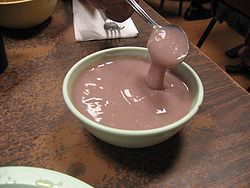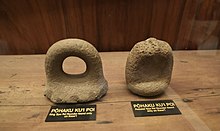
Breadfruit is a species of flowering tree in the mulberry and jackfruit family (Moraceae) believed to be a domesticated descendant of Artocarpus camansi originating in New Guinea, the Maluku Islands, and the Philippines. It was initially spread to Oceania via the Austronesian expansion. It was further spread to other tropical regions of the world during the Colonial Era. British and French navigators introduced a few Polynesian seedless varieties to Caribbean islands during the late 18th century. Today it is grown in some 90 countries throughout South and Southeast Asia, the Pacific Ocean, the Caribbean, Central America and Africa. Its name is derived from the texture of the moderately ripe fruit when cooked, similar to freshly baked bread and having a potato-like flavor.
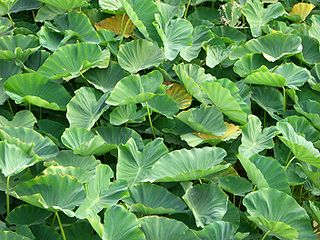
Colocasia is a genus of flowering plants in the family Araceae, native to southeastern Asia and the Indian subcontinent. Some species are widely cultivated and naturalized in other tropical and subtropical regions.
In the Hawaiian religion, Wākea, the Sky father weds Papahānaumoku, the earth mother. The two are considered the parent couple of the ruling chiefs of Hawaii.

A lūʻau is a traditional Hawaiian party or feast that is usually accompanied by entertainment. It often features Native Hawaiian cuisine with foods such as poi, kālua puaʻa, poke, lomi salmon, lomi oio, ʻopihi, and haupia, and is often accompanied with beer and entertainment such as traditional Hawaiian music, kanikapila, and hula. Among people from Hawaiʻi, the concepts of "lūʻau" and "party" are often blended, resulting in graduation lūʻau, wedding lūʻau, baby lūʻau, and birthday lūʻau.
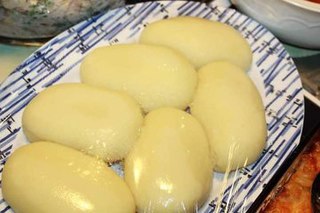
Fufu is a pounded meal found in West African cuisine. It is a Twi word that originates from the Akans in Ghana. The word has been expanded to include several variations of the pounded meal found in other African countries including Sierra Leone, Guinea, Liberia, Cote D'Ivoire, Burkina Faso, Benin, Togo, Nigeria, Cameroon, the Democratic Republic of Congo, the Central African Republic, the Republic of Congo, Angola and Gabon. It also includes variations in the Greater Antilles and Central America, where African culinary influence is high.

The cuisine of Hawaii incorporates five distinct styles of food, reflecting the diverse food history of settlement and immigration in the Hawaiian Islands.[a]

Taro is a root vegetable. It is the most widely cultivated species of several plants in the family Araceae that are used as vegetables for their corms, leaves, stems and petioles. Taro corms are a food staple in African, Oceanic, East Asian, Southeast Asian and South Asian cultures. Taro is believed to be one of the earliest cultivated plants.

Haupia is the Hawaiian name for a traditional coconut pudding found throughout Polynesia.
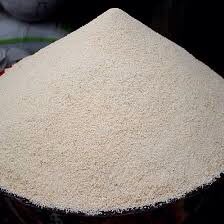
In West Africa, garri is the flour of the fresh starchy cassava root.

Kūlolo is a Hawaiian dish made with taro and coconut. Considered a pudding, kūlolo has a chewy and solid consistency like fudge or Southeast Asian dodol, with a flavor similar to caramel or Chinese nian gao. Because taro is widely cultivated on the island of Kauai, taro products such as kūlolo is often associated with the island. It is a well-beloved dish well documented by many non-Hawaiians since the late 1800s, sometimes found during festive occasions like at lūʻau.

Sundanese cuisine is the cuisine of the Sundanese people of Western Java, and Banten, Indonesia. It is one of the most popular foods in Indonesia. Sundanese food is characterised by its freshness; the famous lalab eaten with sambal and also karedok demonstrate the Sundanese fondness for fresh raw vegetables. Unlike the rich and spicy taste, infused with coconut milk and curry of Minangkabau cuisine, the Sundanese cuisine displays the simple and clear taste; ranged from savoury salty, fresh sourness, mild sweetness, to hot and spicy.

Cyrtosperma merkusii or giant swamp taro, is a crop grown throughout Oceania and into South and Southeast Asia. It is a riverine and "swamp crop" similar to taro, but "with bigger leaves and larger, coarser roots." There are no demonstrably wild populations today, but it is believed to be native to Indonesia. It is known as puraka in Cook Islands, lak in Yap, babai in Kiribati, iaraj in the Marshall Islands, brak in Palau, babaʻ in the Marianas Islands, pula’a in Samoa, via kana, Pulaka in Lau, Lovo in Fiji, pulaka in Tokelau and Tuvalu, mwahng in Pohnpei, pasruk in Kosrae, simiden in Chuuk, swam taro in Papua New Guinea, navia in Vanuatu and palawan in the Philippines.
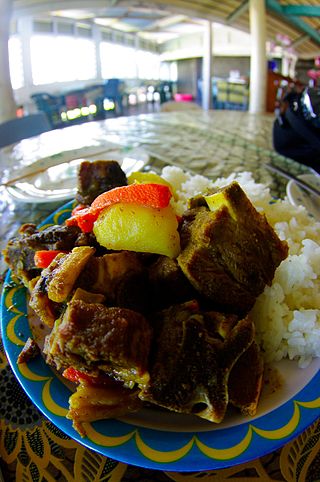
The cuisine of Tuvalu, a state in the Central Pacific (Oceania), is based on the staple of coconut and the many species of fish found in the ocean and the lagoons of the atolls of Tuvalu. Pulaka,, or swamp taro, is an important source of carbohydrates. Rice now forms an important part of the diet. Coconut is used in different forms with coconut water, coconut milk and the flesh of the coconut being used to flavour dishes. Various desserts made on the islands include coconut and coconut milk, instead of animal milk.

The cuisine of Solomon Islands has developed over 5,000 years of inhabitation and external influences. From the Spanish, the islands received cattle; from the Asians and Indians, spices, exotic vegetables and fruit.
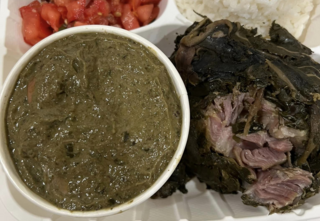
Lūʻau, Luʻau, Laulau, Lū, Rourou, Rukau, Fāfā, Hāhā, and Palusami are all related dishes found throughout Polynesia based on the use of taro leaves as a primary ingredient. While taro generally is known as a root vegetable for its starchy corms, the leaves are consumed as well. The base recipe is vegetarian. Most often, coconut milk was added, and later meat or seafood. The texture of the dish range from a thick soup to a dense cake.

Native Hawaiian cuisine refers to the traditional Hawaiian foods that predate contact with Europeans and immigration from East and Southeast Asia. The cuisine consisted of a mix of indigenous plants and animals as well as plants and animals introduced by Polynesian voyagers, who became the Native Hawaiians.
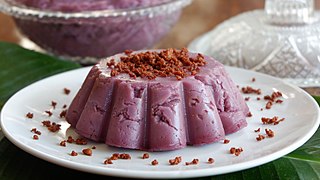
Ube halaya or halayang ube is a Philippine dessert made from boiled and mashed purple yam. Ube halaya is the main base in ube/purple yam flavored-pastries and ube ice cream. It can also be incorporated in other desserts such as halo-halo. It is also commonly anglicized as ube jam, or called by its original native name, nilupak na ube.
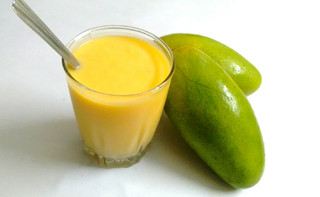
Poi is a traditional Samoan dessert made from mashing fruit into a smooth consistency and mixing in coconut milk and other flavourings.
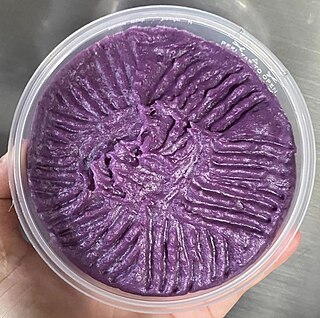
Kōʻelepālau, or pālau, is a Hawaiian pudding made primarily with cooked sweet potatoes mixed with coconut cream. It is similar to other Native Hawaiian puddings like kūlolo and piele.
